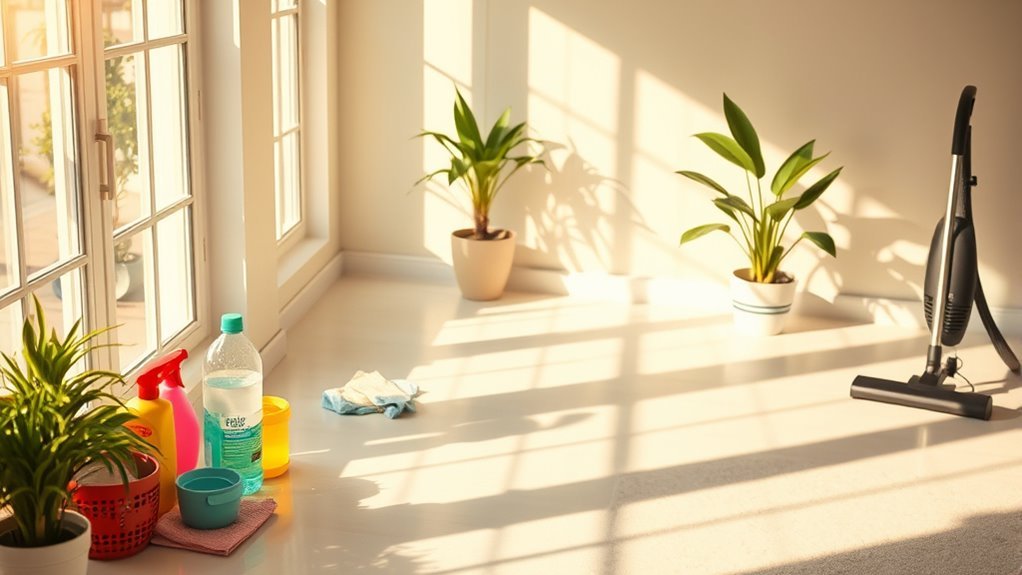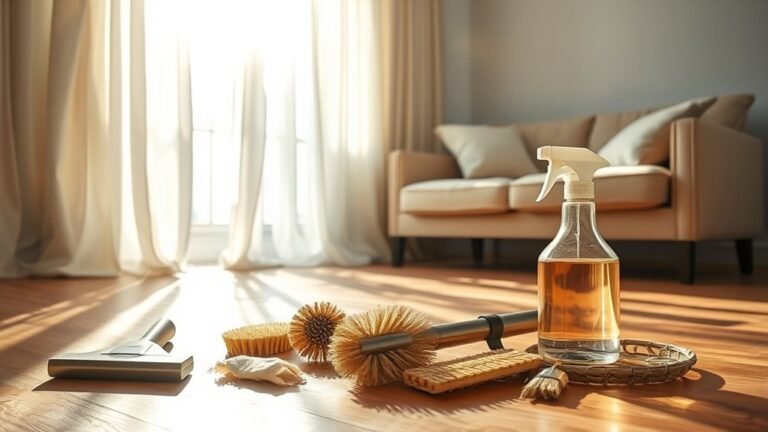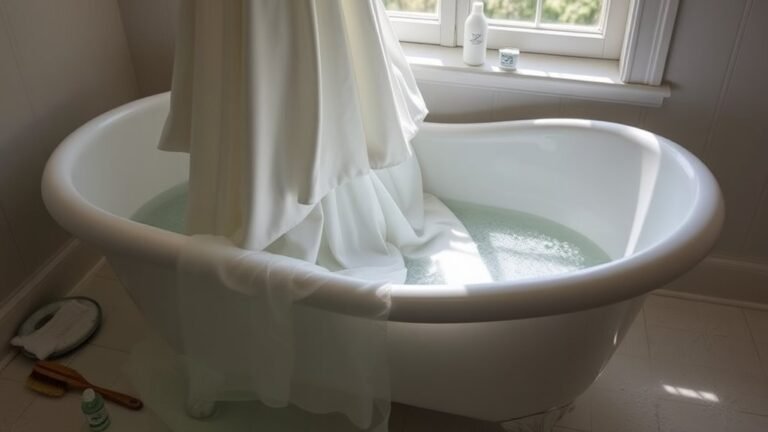How to Clean Your Allergens Safely
To clean allergens safely, choose hypoallergenic, fragrance-free products and wear gloves and a mask to protect yourself. Use damp microfiber cloths for dusting, vacuum with a HEPA filter slowly, and mop floors with allergen-friendly tools. Manage pet dander by brushing pets outdoors and washing their bedding often. Control mold by fixing leaks and using safe cleaners with proper ventilation. Following these easy steps can help reduce allergic reactions. You’ll find even more helpful tips ahead.
Understanding Common Household Allergens

Allergens are tiny substances that can trigger allergic reactions, and many of them are found right inside your home. Recognizing common irritants like dust mites, pet dander, mold spores, and pollen is your first step toward reclaiming control over your space. These allergen sources often hide in carpets, bedding, and even your HVAC system. You don’t have to be a cleaning expert to tackle them; understanding where these irritants lurk helps you focus your efforts efficiently. By targeting these common irritants, you free yourself from constant sneezing and discomfort, allowing you to enjoy your home without restrictions. Knowing what you’re up against empowers you to create a healthier environment on your terms, without feeling trapped by unseen allergens.
Choosing Allergy-Friendly Cleaning Products
When picking cleaning products, you’ll want to look for hypoallergenic ingredients that minimize irritation. Choosing fragrance-free options can also help reduce allergic reactions. Make sure to avoid harsh chemicals that might worsen your symptoms or damage surfaces.
Hypoallergenic Ingredients
Picking the right cleaning products can make a big difference in reducing allergy symptoms at home. When choosing hypoallergenic cleaners, look for natural alternatives that avoid harsh chemicals, dyes, and additives. These ingredients minimize irritation and keep your space safe and fresh without compromising your freedom to breathe easy.
Here’s a quick guide to common hypoallergenic ingredients:
| Ingredient | Benefit |
|---|---|
| Baking Soda | Neutralizes odors, gentle clean |
| White Vinegar | Cuts grease, natural disinfectant |
| Castile Soap | Plant-based, mild on skin |
| Essential Oils* | Antimicrobial, adds subtle scent |
*Use sparingly, as some may cause sensitivities. By picking wisely, you maintain a clean home and protect your health with freedom.
Fragrance-Free Options
While natural ingredients can reduce irritation, fragrances—whether synthetic or natural—often trigger allergic reactions. You want cleaning products that respect your space without compromising your health, so choosing fragrance free cleaning options is key. These products eliminate added scents that can cause sneezing, headaches, or skin irritation, giving you the freedom to clean confidently. If you still crave a fresh aroma, look for natural scent alternatives like essential oils or botanicals, but use them sparingly and test your sensitivity first. Prioritizing fragrance free cleaning helps you maintain a safe, allergen-friendly environment while avoiding unnecessary triggers. Embrace products that protect your well-being and let you breathe easy in your home, free from overpowering chemical perfumes.
Avoiding Harsh Chemicals
Since harsh chemicals can worsen allergies and irritate sensitive skin, you’ll want to choose cleaning products carefully. Opt for natural alternatives that rely on plant-based ingredients instead of synthetic chemicals. Green cleaning products not only protect your health but also reduce environmental impact, giving you the freedom to maintain a safe, allergen-free space without compromise. Look for labels that highlight non-toxic, biodegradable, and hypoallergenic qualities. Avoid products with strong fragrances, dyes, or harsh preservatives that can trigger reactions. By embracing gentle, effective green cleaning solutions, you’re taking control of your environment—keeping allergens at bay while staying true to your values. This approach lets you clean confidently and safely, creating a healthier home that supports your well-being and freedom from irritants.
Preparing Your Cleaning Gear Safely
Before you start cleaning, make sure you pick non-toxic supplies to keep allergens at bay without adding irritants. Don’t forget to wear protective gear like gloves and masks to shield yourself during the process. Finally, organize your tools so everything’s easy to reach and you can clean efficiently.
Choose Non-Toxic Supplies
Although it might be tempting to grab any cleaning product off the shelf, choosing non-toxic supplies is essential for keeping allergens—and your health—under control. By opting for eco friendly alternatives, you reduce exposure to harsh chemicals that can irritate your respiratory system and trigger allergies. Green cleaning products not only protect you but also minimize environmental harm, giving you the freedom to clean without guilt. Look for labels that highlight natural ingredients and avoid artificial fragrances or dyes, which often worsen sensitivities. Making this simple switch empowers you to maintain a safe, allergen-free space while honoring your well-being and the planet. Remember, the right supplies set the foundation for effective, safe cleaning that supports your lifestyle and health goals.
Wear Protective Equipment
When you gear up for cleaning allergens, wearing protective equipment is essential to shield yourself from irritants and chemicals. Slip on protective gloves to keep allergens and cleaning agents off your skin, preventing irritation and allergic reactions. Don’t forget safety goggles to protect your eyes from airborne particles and splashes—your eyes deserve a shield, too. Choosing the right gear gives you the freedom to clean thoroughly without worry. Make sure your gloves fit well, so you maintain dexterity and comfort while tackling allergens. Safety goggles should seal comfortably around your eyes, blocking out dust and sprays effectively. By suiting up properly, you take control of your cleaning routine, keeping yourself safe and free to breathe easy.
Organize Cleaning Tools
Three simple steps can help you organize your cleaning tools effectively, making your allergen removal safer and more efficient. First, gather all your cleaning supplies to avoid unnecessary trips and interruptions. Next, designate a specific area for organizing your workspace, keeping everything neat and accessible. Finally, arrange items based on their purpose and frequency of use to speed up your workflow.
- Sort cleaning supplies by type: sprays, cloths, gloves, and vacuums
- Store frequently used items within arm’s reach
- Label containers to avoid confusion and cross-contamination
- Keep hazardous products separate from general tools
Dusting Techniques to Minimize Allergen Spread
How can you dust effectively without sending allergens airborne? The key lies in smart dusting techniques that trap particles rather than scatter them. Use a damp microfiber cloth or electrostatic duster to capture dust instead of pushing it around. Avoid dry dusters or feather dusters—they just stir allergens into the air, increasing allergen spread. Work from top to bottom, tackling higher surfaces first so settled dust falls to floors you’ll clean later. Don’t rush; slow, deliberate strokes reduce airborne particles. If you’re sensitive, open a window for ventilation and wear a mask. These simple habits let you maintain your space without feeling trapped by allergens, giving you freedom to breathe easy while keeping dust under control.
Effective Vacuuming for Allergy Control

After dusting, the next step to keep allergens at bay is vacuuming, which helps remove particles that settle deep into carpets and upholstery. To make the most of your vacuuming routine and enjoy allergen-free freedom, keep these points in mind:
Vacuuming after dusting removes deep-set allergens from carpets and upholstery to keep your home fresh.
- Use vacuums with HEPA filters to trap tiny allergens effectively.
- Regularly check and clean vacuum filters and bags following vacuum maintenance tips to maintain suction power.
- Utilize attachment benefits: brush and crevice tools reach tight spots and upholstery where allergens hide.
- Vacuum slowly and cover all carpet areas thoroughly to lift embedded particles.
Cleaning Floors Without Stirring Up Allergens
When cleaning floors, you’ll want to pick tools that trap allergens instead of spreading them around. Using microfiber mops and damp cloths can help remove dust effectively without kicking it up into the air. Let’s explore the best methods to keep your floors allergen-free and safe.
Choosing Allergen-Friendly Tools
Although cleaning floors is essential for reducing allergens, using the wrong tools can actually make the problem worse by stirring up dust and particles. To keep your space truly allergen-free, choose tools made from allergen free materials that minimize airborne irritants. Opting for eco friendly tools not only protects your health but also the planet, giving you freedom from harsh chemicals.
When selecting your cleaning gear, consider:
- Microfiber mops that trap dust instead of scattering it
- Vacuum cleaners with HEPA filters for superior allergen capture
- Non-toxic, biodegradable cleaning pads and cloths
- Lightweight, ergonomic handles for easy, stress-free use
These choices empower you to clean effectively without compromising your well-being or environmental values.
Effective Dust Removal Methods
Choosing the right tools sets the stage, but how you use them matters just as much to prevent allergens from becoming airborne. When dusting, grab microfiber cloths—they trap dust instead of pushing it around, keeping allergens locked in. For floors, avoid dry sweeping; it stirs up more dust than you realize. Instead, vacuum with a machine equipped with HEPA vacuum filters to capture fine particles effectively. Move slowly and methodically to guarantee thorough cleaning without kicking up allergens. If you mop, dampen your cloth or mop head to catch dust rather than spreading it. By adopting these methods, you gain control over your environment, reducing allergen exposure and giving yourself the freedom to breathe easy in your own home.
Managing Pet Dander During Cleaning

Since pet dander can trigger allergies and worsen indoor air quality, managing it effectively during cleaning is essential. You want to keep your space fresh without feeling trapped by allergens. Start by creating allergen free zones, especially in bedrooms, to reduce exposure. Regular pet grooming helps minimize dander buildup—try these pet grooming tips:
- Brush your pet outdoors to prevent dander from spreading inside.
- Bathe your pet regularly with hypoallergenic shampoo.
- Vacuum with a HEPA filter to capture airborne dander.
- Wash pet bedding frequently in hot water.
Mold Prevention and Safe Removal Practices
Mold can quickly become a serious problem if you don’t address moisture and humidity in your home. To keep your space allergen-free, start by identifying mold sources like leaks, damp basements, or poor ventilation. Controlling humidity below 50% with dehumidifiers or fans helps prevent mold growth. When it comes to removal techniques, never mix cleaners—use a solution of water and detergent for small patches, or a diluted bleach mixture for tougher spots. Always wear gloves and a mask to protect yourself during cleanup. For extensive mold infestations, consider professional removal to guarantee safety and thoroughness. By tackling moisture and applying proper removal techniques, you can reclaim your home’s freedom from mold and breathe easier.
Washing Bedding and Fabrics to Reduce Allergens
Controlling moisture and removing mold is just one step in reducing allergens at home. Next, focus on washing your bedding and fabrics regularly to keep allergens at bay. Pay attention to bedding frequency—aim to wash sheets and pillowcases at least once a week. Different fabric types hold allergens differently, so consider these tips:
- Wash synthetic fabrics in hot water to kill dust mites effectively.
- Use allergen-proof covers for pillows and mattresses made of breathable materials.
- Avoid heavy, hard-to-clean fabrics that trap dust and allergens.
- Dry bedding thoroughly to prevent moisture buildup and mold growth.
Maintaining Air Quality While Cleaning
While cleaning is essential to reduce allergens, it can sometimes stir up dust and particles that affect your indoor air quality. To keep your space fresh and breathable, pay attention to ventilation importance—open windows or use exhaust fans to let fresh air flow freely. This simple step helps push allergens out and floods your home with cleaner air. You might also consider the air purifiers benefits; using a quality purifier can capture microscopic particles you might miss while cleaning, giving your lungs a break. By combining proper ventilation with air purifiers, you maintain a healthier environment without feeling trapped by allergens. Embrace these practices, and you’ll enjoy a cleaner home and the freedom to breathe easy every day.
Frequently Asked Questions
Can Certain Foods Help Reduce Allergy Symptoms at Home?
Oh sure, just eat your way out of allergies—because that’s totally how it works, right? Well, actually, certain food sources like omega-3 rich fish, ginger, and honey can offer some allergy relief by reducing inflammation and soothing symptoms. You don’t have to be a slave to meds; embracing these natural options can give you more freedom to enjoy life without constant sneezing fits or itchy eyes. It’s a tasty form of rebellion against allergies!
How Often Should I Replace Air Filters for Allergy Control?
You should replace your air filters every 1 to 3 months to keep allergies at bay. Regular air filter maintenance is key to allergy prevention, ensuring your indoor air stays fresh and free from irritants. If you have pets or live in a dusty area, changing filters more often helps you breathe easier. Staying on top of this simple task lets you enjoy your space without sneezing or discomfort.
Are There Natural Remedies to Soothe Allergy Symptoms After Cleaning?
Absolutely, you can soothe your allergy symptoms naturally after cleaning. Herbal teas like chamomile or peppermint are great for calming irritation and reducing inflammation. You might also want to try essential oils such as eucalyptus or lavender; they can ease congestion and promote relaxation. Just remember to use them safely—diffuse or dilute essential oils properly. These natural remedies let you take control and find relief without relying on harsh chemicals.
What Are the Best Plants for Improving Indoor Air Quality?
Oh sure, just invite a jungle indoors—because who doesn’t want a mini rainforest in their living room? But seriously, air purifying plants like snake plants, spider plants, and peace lilies do wonders for your indoor greenery and air quality. They’re nature’s little rebels, freeing you from stale, polluted air. So, embrace these green allies; they quietly fight toxins while you enjoy a gust of clean freedom right at home.
Can Humidity Levels Affect Allergen Presence in My Home?
Yes, humidity levels can greatly impact allergen growth in your home. When humidity’s too high, it creates the perfect environment for mold, dust mites, and other allergens to thrive. On the flip side, very low humidity can dry out your respiratory tract, making you more sensitive to allergens. Keeping humidity effects balanced—ideally between 30-50%—helps reduce allergen presence and lets you breathe freely without worry.






